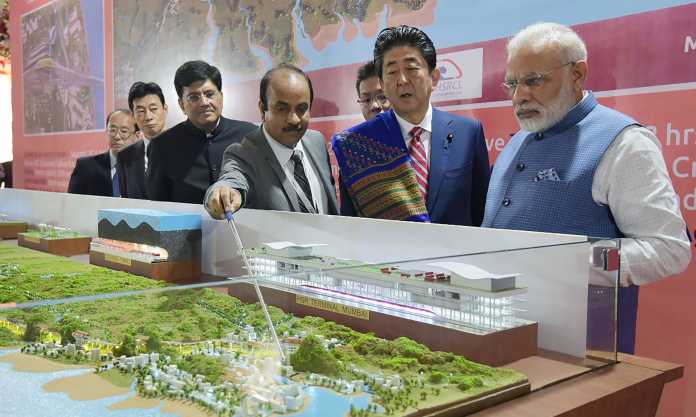Indians have great news to rejoice about! India’s dream of a bullet train is finally taking shape. Prime Minister Narendra Modi and Japanese Prime Minister Shinzo Abe, who is visiting India, laid the foundation stone for the ambitious Mumbai-Ahmedabad bullet train project at Ahmedabad on 14th September 2017. The government has set the deadline for the completion of this magnificent infrastructure project as 2022, which marks the 75th year of India’s independence. The 534-km high-speed rail project will not only be a game-changer in terms of inter-urban connectivity and high technology projects, but will also solidify Indo-Japanese ties.
In what is being seen as one of India’s historic days, the bullet train plan launch ceremony has been a tremendous success with thousands of people welcoming the project. One of the biggest outcomes will be the amount of employment generated, also enabling Indian engineers and labor to gain expertise and skills to ‘Make in India’ the parts and rolling stock. India will import the iconic ‘Shinkansen’ bullet-train technology from Japan. PM Narendra Modi thanked PM Shizo Abe at the ceremony for Japan’s immense contribution and support. The two leaders exchanged enthusiastic compliments, committed to sustain and improve their ties and make the Indo-Japanese relationship a long-term and mutually beneficial one. PM Modi said ” This project exemplifies a new India and is an expression of its dreams, its flight is limitless, its aspirations infinite, this is an India that is flying high”.
Here are 10 facts about the highly anticipated project that will change India’s face on the global front-
- The giant infrastructure project will cost India approximately Rs 1,10,000 crore.
- Japan will provide a loan of Rs 88,000 crore to India at an interest rate of 0.1%, which can be paid over a period of 50 years.
- The estimated time of completion was by 2023, but Railway Minister Piyush Goyal said PM Modi is confident that India will achieve it by 2022.
- The bullet train will run between Ahmedabad and Mumbai, carrying 750 passengers in its 10 coaches. The government aims to add 6 more coaches later to increase the capacity to 1250 passengers.
- Initially, 35 bullet trains will operate. It is expected that bullet trains will do 70 Ahmedabad-Mumbai sorties in a day.
- 24 bullet trains will be imported from Japan but the rest will be manufactured in India, reported IANS.
- The government-claimed ‘affordable for all ride’ will cost somewhere close to the Rajdhani Express AC two tier.
- Passengers will get to travel under the sea, near Thane in Maharashtra for 7 km through a 21-km long tunnel.
- The train will run on two plans shared by the Indian railways. One will halt at all stations, taking 2 hours and 58 minutes. The other, which will stop at selected stations, will take 2 hours and 7 minutes. The bullet train is expected to run at an operational speed of 320 kmph and a maximum speed of 350 kmph.
- The government hopes to employ several safety and security measures such as zero fatality, lowest delay, disaster predictions, and disaster management techniques.
The Government of India is clearly enthusiastic about this project, and members of the government took to twitter to share the development which will make India reach new heights.
#BulletTrain4Growth marks the beginning of a new era in India-Japan ties & a new chapter in India’s transportation/infrastructure sector.
— Smriti Z Irani (@smritiirani) September 14, 2017
2/ A strong India is good for Japan and a strong Japan is good India: PM Japan @AbeShinzo, #BulletTrain pic.twitter.com/RvYEpNYDkG
— Ministry of Railways (@RailMinIndia) September 14, 2017
आधुनिक तकनीक, बेहतरीन सुरक्षा व तेज गति का संगम बुलेट ट्रेन विश्वस्तरीय सुविधा के साथ साथ लाखों रोजगार पैदा करेगी। pic.twitter.com/s2VG1lv8R4
— Piyush Goyal (@PiyushGoyal) September 13, 2017
मैं जापान का बहुत-बहुत आभार व्यक्त करता हूँ जो इस प्रोजेक्ट के लिए तकनीक और आर्थिक मदद के साथ भारत के सहयोग के लिए आगे आया है: PM Modi
— PMO India (@PMOIndia) September 14, 2017






























